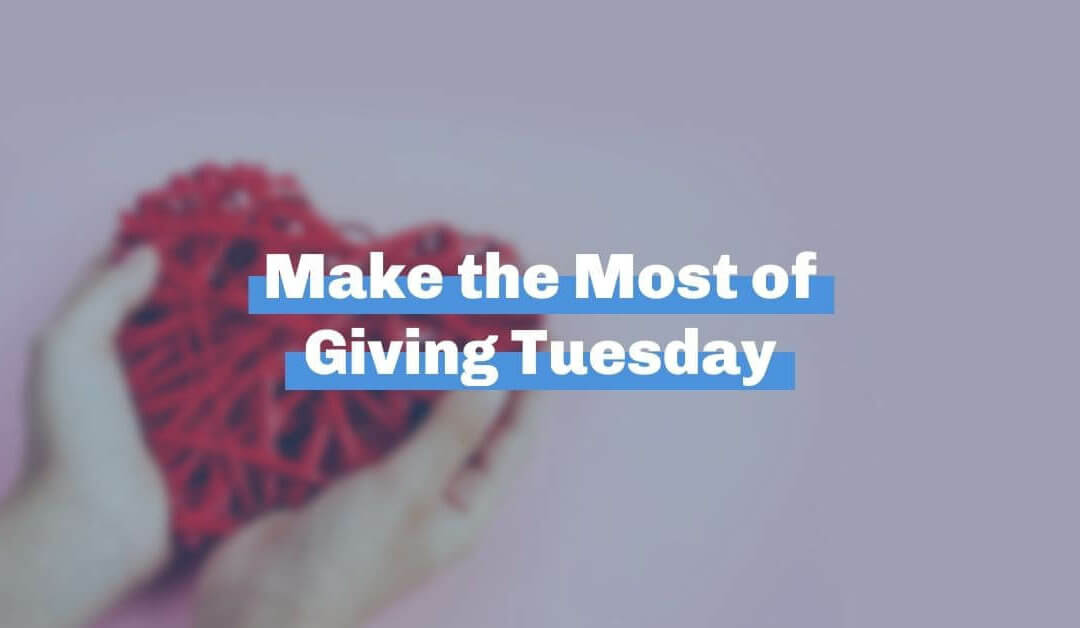
by Sydney Bartlett | Sep 16, 2021 | Donor Engagement, Year-End
Mark your calendars! Giving Tuesday, a day of global generosity held annually on the Tuesday after Thanksgiving, falls on November 30th this year!
In its first year (2012), organizations collectively raised $10 million on Giving Tuesday—and the day’s impact has only grown since then. Now, it’s a key fundraiser on most nonprofit calendars, extending across social media platforms and into 75 countries. Last year, Giving Tuesday propelled 34.8 million people to donate $2.47 billion to U.S. nonprofits—a 29% increase in donations from 2019!
With over two months to spare, the time to prepare for Giving Tuesday is right now.
Whether you’re a Giving Tuesday pro implementing a legacy program, trying to get a budding program off the ground, or looking to reach supporters in a brand new way, now’s the time to get started on a creative, holistic plan! (Did you know that 82% of nonprofits report using Giving Tuesday to try something new? Even donors themselves use Giving Tuesday to interact with their favorite organizations in unique ways—35% of donors give time or goods in addition to financial support!)
If you’re ready to make this year’s Giving Tuesday the best (and most creative) yet, here are a few helpful tips.
Secure a matching gift for donations on Giving Tuesday
A matching gift is the perfect way to build momentum and interest in your campaign. Research has shown that donors are more likely to give when an organization is able to leverage a matching gift, and one-third of donors make larger gifts with the guarantee of a matching donation.
Usually, the most likely candidates to provide a matching gift are ones that are already close to your organization—so think about asking board members, major donors, or corporate sponsors who are already in your donor file. Who are people in those categories who have not yet made their donation this year? Could this be a unique way to activate them?
Approach the ask with confidence and gratitude. Come to your meeting with potential donors prepared: have a plan to market the match and share exactly what programs their match would support. Remember, a matching donation doubles their gift, too.
Create energy on Giving Tuesday. Use it as a day of celebration and excitement!
The end of the year is an exciting time for many organizations—and Giving Tuesday is no exception! Think of it as a celebration, and use it as a way to build excitement for giving during the remainder of the year. We all want to be part of a celebration, and that sentiment applies to your donors, too. Create a culture of excited giving by planning ahead and tailoring your asks to individual supporters.
Giving Tuesday sets the tone for the remainder of your year’s giving; do your organization (and your donors!) a favor by entering the season with celebration!
Be ready to thank everyone who gave on Giving Tuesday
The most thoughtful thank yous are the ones you’re ready to make. We all know that thanking our supporters frequently and consistently is important. Gratitude for donors is a key indicator of how likely we are to retain them, and keeping your current donors is far more cost effective than finding new ones. Our tip: prepare your thank yous in advance. That way you can make those acknowledgments as unique as your donors, while ensuring the process is seamless by the time Giving Tuesday comes around.
Feeling stuck in your typical thank you routine? Freshen up your plan with a few tips from us (think: handwritten notes, magnets, and more!).
Have a plan to ask for another gift before the year ends
Giving Tuesday is just the beginning of the year’s busiest giving season and it’s in your best interest to view your Giving Tuesday plan holistically. How can this event prepare you for the remainder of your year-end asks? 53.8% of nonprofits begin planning their end-of-year campaigns in October, so make your Giving Tuesday and year-end plans work in tandem. Use this time to add momentum to your year-end campaign.
(Need a jumpstart on planning your campaign communications? We’ve got you covered!)
Don’t forget: the two biggest giving days of the year fall after Giving Tuesday and 12% of the year’s total giving happens in the final three days of December.
Evaluate your Giving Tuesday efforts quickly so that you can gain valuable information for the remainder of your year-end campaign. Did you find any new donors? Notice any unique giving patterns? Discover that one social media platform propelled more gifts than another? Take these insights into the remainder of your year-end campaign, and continue using the communication and marketing strategies that worked!
*
Your donors want to support your work. Follow the tips above and communicate the things that make your organization vital and unique. Celebrate your mission with your community on November 30th—and beyond! We’ll be cheering you on the whole way.

by Sydney Bartlett | Apr 5, 2021 | Donor Engagement, Year-End
It may seem like your year-end campaign was just a few months ago, but, in reality, your year-end campaign is just a few months away! Don’t wait for the weather to turn cold before you begin to prepare for year-end. Get yourself ready now with these five recommendations guaranteed to save a few headaches (and enhance your fundraising!) down the line.
Review your donor thank you process and set yourself up for your next ask.
Stewardship doesn’t wait for year-end. Your supporters want to feel appreciated and involved in your organization all year long, and reviewing (and revamping!) that thank you process now will maximize your future asks. Fronstream reports that “80% of [first-time] donors say a simple ‘thank you’ would convince them to make a second donation.” Guidestar writes that a failure to acknowledge gifts is one of the primary reasons donors stop giving.
We’ll give you a few quick do’s and don’ts:
Do thank your donors quickly!
The Modern Nonprofit recommends that, ideally, donors receive a thank you within 24 hours of a gift but no later than one week.
Do thank your donors often!
Creating multiple touch points with your donors throughout the year is key. Alexander Haas suggests six curated interactions with donors throughout the year, ranging from thank you cards to newsletters and personal invitations.
Don’t make it all about your organization
Thanking your donors is about emphasizing their impact. Guidestar proposes a “3:1 ratio of ‘You’ vs. ‘We’” language.
Don’t use it just to ask for something else
Bloomerang stresses that your thank you is “not the time to solicit another gift.” Gratitude for gratitude’s sake is always a good idea.
Setting a top-notch thank you process in motion now will build the foundation you need to make a confident ask at the end of this year.
Sharpen up and simplify your donation forms.
Donating to your organization should be easy and appealing. The less complicated it is to make a gift, the more likely it is that your supporters will give—now and at year-end. Classy underscores the importance of clear donor forms: “It’s not about making people act without thinking, it’s about making it easy to do the right thing.”
Simplifying your donor forms doesn’t have to be hard, either. Keep your form short by reducing excess language and refraining from long-winded sentences. Don’t give your donor more information than they need to make their gift. Donorbox emphasizes minimalism and warns against clutter on donation forms while offering Code for America and Shanti Bhavan Children’s Project as examples for easy, effective donor forms.
The fewer barriers that your supporters run into while making a gift, the more likely it is that you’ll see that gift in your organization’s bank account. By the time year-end rolls around, your donors will thank you for a clear-cut avenue to gifting—and you’ll be thanking yourself (and them, of course!), too.
Still looking for a simple, affordable, convenient, and effective way to collect online gifts? We’ve got you covered! Swell is an online giving tool that makes it easy and awesome to raise money online. To learn more and get set up, contact us.
Clean up your lists.
Knowing who you’re inviting to make a year-end gift—and where you’re sending your request—can make or break your campaign. Whether it’s a direct mail or email campaign, accurate donor information is key to getting the right message to the right supporters. A clean donor list is a responsive donor list, according to Get Fully Funded. Start by creating (and using!) data entry rules, marking donor preferences, and finding and merging duplicate records. If possible, fill in missing holes in donor data by reaching out to them now so that you’re ready to talk to them across multiple channels in a few months.
With up-to-date donation and contact information, segmenting your year-end lists and creating your mail merges will be seamless. Whether you’re sending an email or dropping letters in the mail this winter, The Modern Nonprofit recommends practicing data hygiene now to save time and money in the future.
Tell your donors what their 2020 year-end gift made possible.
If you want the donors who gave to last year’s campaign to give again, they’ll need to know that their past gift made a difference. According to Candid, donors want to know more about your organization’s work than your needs, so it’s important to share impact stories all year long. Likewise, Causevox says that donor communication needs to go beyond the thank you. Supporters should know the impact of their gift. Otherwise, they’ll end up with the 22% of donors that stop giving due to poor communication.
Start telling your supporters what last year’s campaign is doing for your organization in order to build confidence in your work and lay the foundation for future gifts.
Run an acquisition campaign to build your list of leads now.
Diversifying your funding sources is critical to fostering a sustainable organization. Beginning your search for new donors well ahead of year-end gives you the time to implement key stewardship practices prior to making your ask. Donorbox offers 15 techniques to boost your donor acquisition, including relying on the networks of your current donors, goal-setting, and peer-to-peer fundraising.
Many of the tools needed to run a stellar donor acquisition campaign are in your back pocket. Network for Good recommends using the data you already have to get started, and Salsa says to stay close to home when it comes to your campaign. Many of your best prospects are closer than you might believe (think: volunteers!), and when year-end comes around, you’ll have new names (with some familiar faces) on your list.
If you’ve made it this far, you’ve already jump-started your end-of-year campaign. Implementing these five tactics now will position your next year-end to be the best one yet.


